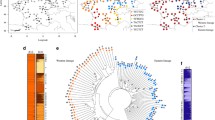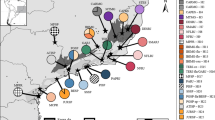Abstract
Since the 1930s, several European zoologists have developed scenarios for glacial refuges and postglacial expansions, mainly based on studies of the morphological differentiation of populations and distribution patterns of species. For example, Holdhaus described the distribution of blind euedaphic and troglobitic beetles restricted to an area South of a well-defined line crossing the Southern Europe from West to East. In these areas, where many endemic animal and plant species occur, other species that are currently more widely distributed in Europe were probably able to survive the glacial period(s). Molecular analyses of 77 populations of the silvicolous ground beetle Carabus auronitens support the existence of these postulated refuge areas. Genetic differentiation of C. auronitens provides good evidence for multiple refuges, which are, however, situated further North than previously assumed. Furthermore, genetic differentiation is more pronounced in the areas South of the “Holdhaus line” than in the areas North of it.
Access this chapter
Tax calculation will be finalised at checkout
Purchases are for personal use only
Similar content being viewed by others
References
Assmann T, Buse J, Drees C, Habel J, Härdtle W, Matern A, von Oheimb G, Schuldt A, Wrase DW (2008) From Latreille to DNA systematics - towards a modern synthesis for carabidology. In: Penev L, Erwin T, Assmann T (eds) Back to the roots or back to the future? Towards a new synthesis amongst taxonomic, ecological and biogeographical approaches in carabidology. Pensoft, Sofia, pp 41–76
Assmann T, Heine S (1993) Die Leistus-Arten der Oreobius-Gruppe: Systematik, Taxonomie und Verbreitung (Coleoptera, Carabidae: Nebriinae). Mitteilungen aus der Entomogischen Gesellschaft Basel 43:42–68
Assmann T, Nolte O, Reuter H (1994) Postglacial colonization of middle Europe by Carabus auronitens as revealed by population genetics (Coleoptera, Carabidae). In: Desender K (ed) Carabid beetles: ecology and evolution. Kluwer, Dordecht, pp 3–9
Assmann T, Weber F (1997) On the allozyme differentiation of Carabus punctatoauratus Germar (Coleoptera, Carabidae). J Zoolog Syst Evol Res 35:33–43
Avon C (1997) Les Duvalius et leur compexe evolutif: Espèces Francaise. Italiennes and Parasites. Laboratoire d’Entomologie Faune Hypogee et Endogee, Cagnes dur Mer (France)
Berggren KT, Ellegren H, Hewitt GM, Seddon JM (2005) Understanding the phylogeographic patterns of European hedgehogs, Erinaceus concolor and E. europaeus using the MHC. Heredity 95:84–90
Bonadona P (1971) Catalogue des Coléoptères Carabiques de France. Nouvelle Revue d’Entomologie Suppl 1:1–177
Breuning S (1932) Monographie der Gattung Carabus L. Reitter, Troppau
Culver DC, White WB (2005) Encyclopedia of caves. Elsevier, Burlington, VT
Casale A, Giachino PM, Vailati D (1991) Brevi considerazioni per una sistematica filogenetica dei Bythysciinae (Coleoptera: Cholevidae). Atti XII Congresso Nazionale Italiano Entomologia Bari, Società Entomologica Italiana, Bari 857–865
Casale A, Vigna-Taglianti A (2005) Coleotteri Caraboidei della Alpi e Prealpi centrali e orientali, e loro significato biogeografico. Biogeographia 26:129–201
Casale A, Vigna-Taglianti A, Juberthie C (1998) Coleoptera Carabidae. In: Juberthie C, Decu V (eds) Encyclopedia biospeologica. Tome II. Société de Biospéologie, Moulis, pp 1047–1081
Cheddadi R, Vendramin GG, Litt T, Francois L, Kageyama M, Lorentz S, Laurent JM, de Beaulieu JL, Sadori L, Jost A, Lunt D (2006) Imprints of glacial refugia in the modern genetic diversity of Pinus sylvestris. Glob Ecol Biogeogr 15:271–282
Chodat R, Pampanini R (1902) Sur la distribution des plantes des Alpes austro-orientales. Le globe: revue genevoise de géographie 41:63–132
Daffner H (1993) Die Arten der Gattung Arctaphaenops Meixner, 1925 (Coleoptera: Carabidae). Koleopterologische Rundschau 63:1–18
De Lattin G (1957) Die Ausbreitungszentren der holarktischen Landtierwelt. Zool Anz 20 (Supplement):380–410
De Lattin G (1959) Postglaziale Disjunktionen und Rassenbildung bei europäischen Lepidopteren. Zool Anz 22 (Supplement):392–403
De Lattin G (1967) Grundriß der Zoogeographie. Fischer, Jena
Desender K (1986) Distribution and ecology of carabid beetles in Belgium (Coleoptera, Carabidae). part 2. Studiedocumenten (Bruxelles) 27:1–24
Deuve T (1994) Une classification du genre Carabus. Sciences Nat, Venette
Dobzhansky T (1937) Genetics and the origin of species. Columbia University Press, New York
Drees C, Matern A, Rasplus JY, Assmann T, Weber F (2008) Microsatellites and allozymes as the genetic memory of habitat fragmentation and defragmentation in populations of the ground beetle Carabus auronitens (Col., Carabidae). J Biogeogr 35:1937–1949
Drovenik B, Weber F, Paill W, Assmann T (2008) Aphaenopidius kamnikensis Drovenik, 1987 in Kärnten. Angewandte Carabidologie 8:73–76
Felsenstein J (2005) PHYLIP (Phylogeny Inference Package) Version 3.6. Department of Genome Sciences, University of Washington, Seattle
Forel J, Leplat J (1995) Les Carabes de France. Science Nat, Venette
Futuyma DJ (2005) Evolution. Sinauer Associates, Sunderland, MA
Garnier S, Alibert P, Audiot P, Prieur B, Rasplus J-Y (2004) Isolation by distance and sharp discontinuities in gene frequencies: implications for the phylogeography of an alpine insect species, Carabus solieri. Mol Ecol 13:1883–1897
Giachino PM, Decu V, Juberthie C (1998) Coleoptera Cholevidae. In: Juberthie C, Decu V (eds) Encyclopaedia biospeologia. Société de Biospéologie, Moulis, pp 1083–1122
Hampe A, Petit RJ (2005) Conserving biodiversity under climate change: the rear edge matters. Ecol Lett 8:461–467
Hewitt GM (1996) Some genetic consequences of ice ages, and their role in divergence and speciation. Biol J Linn Soc 58:247–276
Hewitt GM (1999) Post-glacial re-colonization of European biota. Biol J Linn Soc 68:87–112
Holdhaus K (1906) Verbreitung der Koleopteren in den mitteleuropäischen Hochgebirgen. Verh Zool Bot Ges Wien 56:629–639
Holdhaus K, Lindroth CH (1939) Die europäischen Koleopteren mit boreoalpiner Verbreitung. Naturhistorisches Museum, Wien
Holdhaus K (1954) Die Spuren der Eiszeit in der Tierwelt Europas. Wagner, Innsbruck
Huber C, Molenda R (2004) Nebria (Nebriola) praegensis sp. nov., ein Periglazialrelikt im Südschwarzwald/Deutschland, mit Beschreibung der Larven (Insecta, Coleoptera, Carabidae). Beiträge des Naturhistorischen Museums Bern 2004:1–28
Jaarola M, Searle JB (2002) Phylogeography of field voles (Microtus agrestis) in Eurasia inferred from mitochondrial DNA sequences. Mol Ecol 11:2613–2621
Joger U, Fritz U, Guicking D, Kalyabina-Hauf S, Nagy ZT, Wink M (2007) Phylogeography of Western Palearctic reptiles - spatial and temporal speciation patterns. Zool Anz 246:293–313
Juberthie C, Delay B, Bouillon M (1980a) Sur l’existence d’un milieu souterrain superficiel en zone non calcaire. Comptes rendues de l’academie des sciences - Series III - Life sciences 290:49–52
Juberthie C, Delay B, Ruffat G (1980b) Extension du milieu souterrain en zone non-calcaire: description d’un nouveau milieu et de son peuplement par le Coléoptères troglobies. Mémoires de biospéologie 7:19–52
Kobel-Lamparski A, Lamparski F (2004) Lumbricus badensis - ein Franzose, der in Baden groß wurde. Mitteilungen des badischen Landesvereins für Naturkunde und Naturschutz N.F. 18:91–109
von Koenigswald W (2002) Lebendige Eiszeit - Klima und Tierwelt im Wandel. Theiss-Verlag, Stuttgart
Krebs CJ (1999) Ecological methodology, 2nd edn. Addison Wesley, Menlo Park, CA
Krumbiegel I (1932) Untersuchungen über physiologische Rassenbildung. Ein Beitrag zum Problem der Artbildung und der geographischen Variation. Zoologisches Jahrbuch für Systematik und Ökologie 63:183–280
Krumbiegel I (1936) Morphologische Untersuchungen über Rassenbildung, ein Beitrag zum Problem der Artbildung und der geographischen Variation. Zoologisches Jahrbuch für Systematik und Ökologie 68:105–178
Kryzhanovskij OL, Belousov IA, Kabak II, Kataev BM, Makarov KV, Shilenkov VG (1995) A checklist of the ground-beetles of Russia and adjancent lands (Insecta, Coleoptera, Carabidae). Pensoft, Sofia, Moscow
Lang G (1994) Quartäre Vegetationsgeschichte Mitteleuropas. Fischer, Stuttgart
Löbl I, Smetana A (eds) (2003) Catalogue of Palearctic Coleoptera Vol. 1: Archostemata, Myxophaga, Adephaga. Apollo Books, Stenstrup
Lorenz W (2005) A systematic list of extant ground beetles of the world (Coleoptera “Geadephaga”: Trachypachydiae and Carabidae, incl. Paussinae, Cicindelinae, Rhysodinae). Lorenz, Tutzingen
Magri D (2008) Patterns of post-glacial spread and the extent of glacial refugia of European beech (Fagus sylvatica). J Biogeogr 35:450–463
Magri D, Vendramin GG, Comps B, Dupanloup I, Geburek T, Gomory D, Latalowa M, Litt T, Paule L, Roure JM, Tantau I, van der Knaap WO, Petit RJ, de Beaulieu J-L (2006) A new scenario for the Quaternary history of European beech populations: palaeobotanical evidence and genetic consequences. New Phytol 171:199–221
Malzacher P (2000) Erster Nachweis einer blinden Laufkäfer-Art in Deutschland (Bembidiinae, Anillini). Angewandte Carabidologie 2(3):71–72
Marggi W (1992) Faunistik der Sandlaufkäfer und Laufkäfer der Schweiz (Cicindelidae and Carabidae). Text und Verbreitungskarten. Documenta Faunistica Helvetiae 13/1 and 13/2: 1–477 and 471–243
Michaux JR, Magnanou E, Paradis E, Nieberding C, Libois R (2003) Mitochondrial phylogeography of the Woodmouse (Apodemus sylvaticus) in the Western Palearctic region. Mol Ecol 12:685–697
Nei M (1978) Estimation of average heterozygosity and genetic distance from a small number or individuals. Genetics 89:583–590
Osella G, Zuppa AM (1998) Coleoptera Curculionoidea. In: Juberthie C, Decu V (eds) Encyclopaedia Biospeologia. Tome II. Société de Biospéologie, Moulis, pp 1122–1130
Puisségur C (1964) Recherches sur la génétique des Carabes (Chrysocarabus et Chrysotribax). Vie et Milieu 18:1–288
Reimann T, Assmann T, Nolte O, Reuter H, Huber C, Weber F (2002) Palaeogeography and palaeoecology of Carabus auronitens (Coleoptera): characterization and localization of glacial refugia in Southern France and reconstruction of postglacial expansion routes by means of allozyme polymorphisms. Abhandlungen des Naturwissenschaftlichen Vereins in Hamburg (NF) 35:1–151
Reinig WF (1938) Elimination und Selektion: Eine Untersuchung über Merkmalsprogressionen bei Tieren und Pflanzen auf genetisch- und historisch-chorologischer Grundlage. Fischer, Jena
Reinig WF (1939) Die genetisch-chorologischen Grundlagen der gerichteten geographischen Variabilität. Zeitschrift für induktive Abstammungs- und Vererbungslehre 76:260–308
Rensch B (1929) Das Prinzip geographischer Rassenkreise und das Problem der Artbildung. Gebrüder Borntraeger, Berlin
Rensch B (1939) Typen der Artbildung. Biol Rev 14:180–222
Rensch B (1951) Die Verteilung der Tierwelt im Raum. In: von Bertalanfey (ed) Handbuch der Biologie. Akademische Verlagsgesellschaft Athenaion, Potsdam, pp. 125–172
Rensch B (1960) Evolution above species level. Columbia University Press, New York
Saitou N, Nei M (1987) The Neighbor-joining method: a new method for reconstructing phylogenetic trees. Mol Biol Evol 4:406–425
Schmitt T (2007) Molecular biogeography of Europe: Pleistocene cycles and postglacial trends. BMC Frontiers in Zoology 4:11
Seddon JM, Santucci F, Reeve NJ, Hewitt GM (2001) DNA footprints of European hedgehogs, Erinaceus europaeus and E. concolor. Pleistocene refugia, postglacial expansion and colonization routes. Mol Ecol 10:2187–2198
Spelda J (1991) Zur Faunistik und Systematik der Tausendfüßler (Myriapoda) Südwestdeutschlands. Jahreshefte der Gesellschaft für Naturkunde in Württemberg 146:211–232
Stauffer C, Lakatos F, Hewitt GM (1999) Phylogeography and postglacial colonization routes of Ips typographus L. (Coleoptera, Scolytidae). Mol Ecol 8:763–773
Steinfartz S, Veith M, Tautz D (2000) Mitochondrial sequence analysis of Salamandra taxa suggests old splits of major lineages and postglacial recolonizations of Central Europe from distinct source populations of Salamandra salamandra. Mol Ecol 9:397–410
Terhurne-Berson R, Litt T, Cheddadi R (2004) The spread of Abies throughout Europe since the last glacial period: combined macrofossil and pollen data. Vegetation History and Archaeobotany 13:257–268
Terlutter H (1991) Morphometrische und elektrophoretische Untersuchungen an westfälischen und südfranzösischen Carabus auronitens-Populationen (Col. Carabidae): Zum Problem der Eiszeitüberdauerung in Refugialgebieten und der nacheiszeitlichen Ausbreitung. Abhandlungen des Westfälischen Museums für Naturkunde 53:3–111
Turin H, Penev L, Casale A (2003) The Genus Carabus in Europe. Pensoft, Sofia
Vigna-Taglianti A (1982) Le attuali conoscenze sui Coleotteri Carabidi cavernicolo italiani. Lavori della Societa’ Italiana di Biogeografia. N.S 7:339–430
Weber F, Heimbach U (2001) Behavioural, reproductive and developmental seasonality in Carabus auronitens and Carabus nemoralis (Col., Carabidae). A demographic comparison between two co-existing spring breeding populations and tests for intra- and interspecific competition and for synchronizing weather events. Mitteilungen aus der Biologischen Bundesanstalt für Land- und Forstwirtschaft 382:1–192
Willis KJ, Rudner E, Sumegi P (2000) The full-glacial forests of central and Southeastern Europe. Quatern Res 53:203–213
Willis KJ, van Andel TH (2004) Trees or no trees? The environments of central and Eastern Europe during the Last Glaciation. Quatern Sci Rev 23:2369–2387
Author information
Authors and Affiliations
Corresponding author
Editor information
Editors and Affiliations
Additional information
We dedicate this work to Prof. em. Dr. Friedrich Weber, our former academic supervisor and colleague, without whose tenacity in the study of C. auronitens this paper would not have been possible.
Rights and permissions
Copyright information
© 2010 Springer-Verlag Berlin Heidelberg
About this paper
Cite this paper
Drees, C., Matern, A., von Oheimb, G., Reimann, T., Assmann, T. (2010). Multiple Glacial Refuges of Unwinged Ground Beetles in Europe: Molecular Data Support Classical Phylogeographic Models. In: Habel, J.C., Assmann, T. (eds) Relict Species. Springer, Berlin, Heidelberg. https://doi.org/10.1007/978-3-540-92160-8_11
Download citation
DOI: https://doi.org/10.1007/978-3-540-92160-8_11
Published:
Publisher Name: Springer, Berlin, Heidelberg
Print ISBN: 978-3-540-92159-2
Online ISBN: 978-3-540-92160-8
eBook Packages: Biomedical and Life SciencesBiomedical and Life Sciences (R0)




